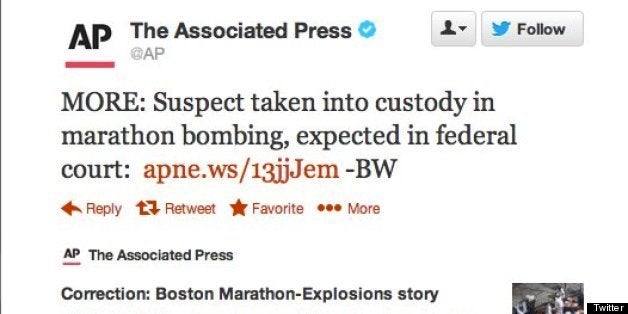
Kathleen Carroll, executive editor of the Associated Press, addressed "some missteps" Monday in the news organization's coverage last week of the Boston marathon attack investigation, including having misreported Wednesday that a suspect was in custody and expected in federal court.
"We took a shellacking, a deserved one, for reporting that a suspect was in custody when, as the hours passed, that information began to look wobbly," Carroll said in a staff memo, obtained by The Huffington Post. "We did carry strong denials from named sources, but we got too caught up in telling readers precisely who-said-what and what had and had not happened. Once we were no longer certain of what we had reported we should have told our audiences that in a clear way. And moved a correction more quickly than we did."
The AP relied on a single source for the Wednesday misstep, which Carroll addressed.
"The one-source rule is very firm in our guidance," Carroll said. "We all know why this is important. The world only occasionally remembers when AP held the line and didn't report something that turned out to be wrong. Our mistakes, however, live on and on and on."
Tom Kent, the AP's deputy managing editor for standards, highlighted some positive aspects of coverage in an accompanying memo, but noted "there were also cases where we violated our principles for one-source stories."
CNN has deservedly received criticism for misreporting Wednesday that an arrest had been made in the Boston marathon bombing investigation, two days before the actual suspects were either killed or captured. But the AP, along with the Boston Globe and Fox News, all made mistakes during the same hectic afternoon.
Carroll's full email to staff, along with suggestions from Kent, is below:
All
Last week was an intense one. Big stories were breaking by the hour -- the Boston bombing and the investigation that stretched to the Russia and the Caucuses, the fertilizer plant explosion in the Texas town of West, ricin mailed to several lawmakers, congressional defeat for toughening access to guns, a large earthquake in China, potential flooding in the Midwest -- and so on.
There was much great work from AP staffers and we celebrate that. But we had some missteps, too. And that's what we want to talk about here today.
Tom Kent, our Deputy Managing Editor for Standards, finished a thoughtful breakdown of where our standards served us well and where we fell short. Two issues stand out.· We made mistakes because we didn't follow our own very good guidelines.
· And in one important case, we did not move quickly enough to clearly to fix that mistake.
The one-source rule is very firm in our guidance. We all know why this is important. The world only occasionally remembers when AP held the line and didn't report something that turned out to be wrong. Our mistakes, however, live on and on and on.
We are going to make mistakes. Our everlasting job is to make sure we make fewer of them and we don't keep making the same ones over and over again. And that when we get something wrong, we are clear about saying so, which is something we didn't do well last week.
We took a shellacking, a deserved one, for reporting that a suspect was in custody when, as the hours passed, that information began to look wobbly. We did carry strong denials from named sources, but we got too caught up in telling readers precisely who-said-what and what had and had not happened. Once we were no longer certain of what we had reported we should have told our audiences that in a clear way. And moved a correction more quickly than we did.
I want to be clear, too, that we are not laying this off on the field leaders. Most of us at headquarters were involved in those discussions and decisions and we are ultimately responsible.
We all need to do better and we will.
Tom's reminders on our guidance follows and he plans to address these with you in his regular staff communications on accuracy.
Kathleen
A note from Tom Kent:
Colleagues,
Our standards review of our Boston coverage found a variety of smart calls, as well as mistakes.
On the plus side, we'll note in particular our restraint in not using questionable reports (the "Saudi suspect" who turned out not to be a factor) and questionable imagery (images of people who turned out not to be the bombers). Other news organizations actively used this material but we remained calm and avoided it.
We also did an excellent job of not dropping attribution from information until we were truly comfortable that it was correct. The importance of maintaining attribution was a key lesson of Newtown, and it was not a problem this time.
But there were also cases where we violated our principles for one-source stories. All AP staffers must be thoroughly familiar with our anonymity guidelines, especially our very exacting criteria when there's only one source of information. According to our News Values and Principles:
The AP routinely seeks and requires more than one source. Stories should be held while attempts are made to reach additional sources for confirmation or elaboration. In rare cases, one source will be sufficient - when material comes from an authoritative figure who provides information so detailed that there is no question of its accuracy.
In addition, in any story with anonymity, we must explain that the source insisted on anonymity and say why he/she could not speak on the record. The simple fact that the subject is "sensitive" or involves an "ongoing investigation" is not enough to explain anonymity.
We also bypassed some other anonymity guidelines. In the example above, justifying anonymity by "the sensitivity of the ongoing investigation" does not satisfy our rules. The test for anonymity is not how sensitive or secret the subject is, but the reason the person cannot speak on the record. For instance, "insisted on anonymity because he was not authorized to speak to reporters."
We must also be clear to readers about what we don't know. In particular, foggy statements by officials and questionable comments by witnesses must be accompanied by a clear statement by us that confirmation or elaboration was not available. If an attacker's motive is not clear, we must say that directly, whatever hints our reporting may have developed about what the motive might have been.
Everyone in the AP is responsible for maintaining these principles.
We will be returning to them, and other lessons from Boston, in coming days.
Tom
